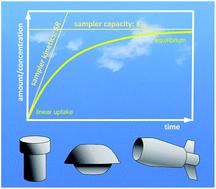当前位置:
X-MOL 学术
›
Environ. Sci.: Processes Impacts
›
论文详情
Our official English website, www.x-mol.net, welcomes your feedback! (Note: you will need to create a separate account there.)
Passive air sampling for semi-volatile organic chemicals.
Environmental Science: Processes & Impacts ( IF 5.5 ) Pub Date : 2020-08-21 , DOI: 10.1039/d0em00194e Frank Wania 1 , Chubashini Shunthirasingham
Environmental Science: Processes & Impacts ( IF 5.5 ) Pub Date : 2020-08-21 , DOI: 10.1039/d0em00194e Frank Wania 1 , Chubashini Shunthirasingham
Affiliation

|
During passive air sampling, the amount of a chemical taken up in a sorbent from the air without the help of a pump is quantified and converted into an air concentration. In an equilibrium sampler, this conversion requires a thermodynamic parameter, the equilibrium sorption coefficient between gas-phase and sorbent. In a kinetic sampler, a time-averaged air concentration is obtained using a sampling rate, which is a kinetic parameter. Design requirements for kinetic and equilibrium sampling conflict with each other. The volatility of semi-volatile organic compounds (SVOCs) varies over five orders of magnitude, which implies that passive air samplers are inevitably kinetic samplers for less volatile SVOCs and equilibrium samplers for more volatile SVOCs. Therefore, most currently used passive sampler designs for SVOCs are a compromise that requires the consideration of both a thermodynamic and a kinetic parameter. Their quantitative interpretation depends on assumptions that are rarely fulfilled, and on input parameters, that are often only known with high uncertainty. Kinetic passive air sampling for SVOCs is also challenging because their typically very low atmospheric concentrations necessitate relatively high sampling rates that can only be achieved without the use of diffusive barriers. This in turn renders sampling rates dependent on wind conditions and therefore highly variable. Despite the overall high uncertainty arising from these challenges, passive air samplers for SVOCs have valuable roles to play in recording (i) spatial concentration variability at scales ranging from a few centimeters to tens of thousands of kilometers, (ii) long-term trends, (iii) air contamination in remote and inaccessible locations and (iv) indoor inhalation exposure. Going forward, thermal desorption of sorbents may lower the detection limits for some SVOCs to an extent that the use of diffusive barriers in the kinetic sampling of SVOCs becomes feasible, which is a prerequisite to decreasing the uncertainty of sampling rates. If the thermally stable sorbent additionally has a high sorptive capacity, it may be possible to design true kinetic samplers for most SVOCs. In the meantime, the passive air sampling community would benefit from being more transparent by rigorously quantifying and explicitly reporting uncertainty.
中文翻译:

半挥发性有机化学品的被动空气采样。
在被动空气采样过程中,无需借助泵就可以定量吸收吸附剂从空气中吸收的化学物质,并将其转换为空气浓度。在平衡采样器中,此转换需要一个热力学参数,即气相和吸附剂之间的平衡吸附系数。在动力学采样器中,使用采样率获得时间平均空气浓度,采样率是动力学参数。动力学和平衡采样的设计要求相互冲突。半挥发性有机化合物(SVOC)的挥发性变化超过五个数量级,这意味着对于挥发性较低的SVOC,被动空气采样器不可避免地是动力学采样器,对于挥发性较高的SVOC,平衡空气采样器不可避免。因此,目前,大多数用于SVOC的无源采样器设计都是一个折衷方案,需要同时考虑热力学参数和动力学参数。它们的定量解释取决于很少满足的假设,并且取决于通常只有高度不确定性才能知道的输入参数。SVOC的动力学被动空气采样也具有挑战性,因为它们通常非常低的大气浓度需要相对较高的采样率,而这只有在不使用扩散屏障的情况下才能实现。反过来,这使得采样率取决于风况,因此变化很大。尽管这些挑战带来了很大的不确定性,SVOC的被动式空气采样器在记录(i)几厘米到几万公里范围内的空间浓度变化,(ii)长期趋势,(iii)偏远且人迹罕至的地方的空气污染等方面发挥着重要作用(iv)室内吸入暴露。展望未来,吸附剂的热解吸可能会降低某些SVOC的检测限,以致在SVOC动力学采样中使用扩散屏障变得可行,这是降低采样率不确定性的前提。如果热稳定的吸附剂还具有较高的吸附能力,则可以为大多数SVOC设计真正的动力学采样器。同时,
更新日期:2020-08-22
中文翻译:

半挥发性有机化学品的被动空气采样。
在被动空气采样过程中,无需借助泵就可以定量吸收吸附剂从空气中吸收的化学物质,并将其转换为空气浓度。在平衡采样器中,此转换需要一个热力学参数,即气相和吸附剂之间的平衡吸附系数。在动力学采样器中,使用采样率获得时间平均空气浓度,采样率是动力学参数。动力学和平衡采样的设计要求相互冲突。半挥发性有机化合物(SVOC)的挥发性变化超过五个数量级,这意味着对于挥发性较低的SVOC,被动空气采样器不可避免地是动力学采样器,对于挥发性较高的SVOC,平衡空气采样器不可避免。因此,目前,大多数用于SVOC的无源采样器设计都是一个折衷方案,需要同时考虑热力学参数和动力学参数。它们的定量解释取决于很少满足的假设,并且取决于通常只有高度不确定性才能知道的输入参数。SVOC的动力学被动空气采样也具有挑战性,因为它们通常非常低的大气浓度需要相对较高的采样率,而这只有在不使用扩散屏障的情况下才能实现。反过来,这使得采样率取决于风况,因此变化很大。尽管这些挑战带来了很大的不确定性,SVOC的被动式空气采样器在记录(i)几厘米到几万公里范围内的空间浓度变化,(ii)长期趋势,(iii)偏远且人迹罕至的地方的空气污染等方面发挥着重要作用(iv)室内吸入暴露。展望未来,吸附剂的热解吸可能会降低某些SVOC的检测限,以致在SVOC动力学采样中使用扩散屏障变得可行,这是降低采样率不确定性的前提。如果热稳定的吸附剂还具有较高的吸附能力,则可以为大多数SVOC设计真正的动力学采样器。同时,



























 京公网安备 11010802027423号
京公网安备 11010802027423号